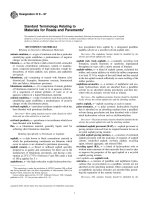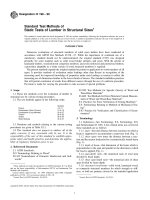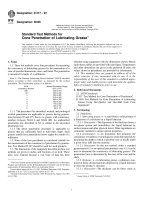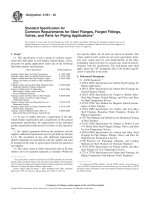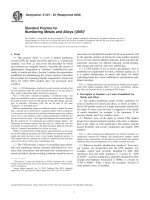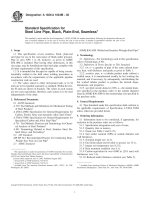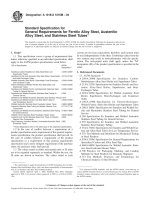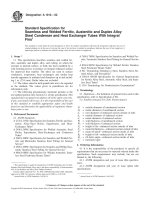Tiêu chuẩn ASTM A 1024A 1024M – 02
Bạn đang xem bản rút gọn của tài liệu. Xem và tải ngay bản đầy đủ của tài liệu tại đây (41.48 KB, 6 trang )
Designation: A 1024/A 1024M – 02
Standard Specification for
Steel Line Pipe, Black, Plain-End, Seamless1
This standard is issued under the fixed designation A 1024/A 1024M; the number immediately following the designation indicates the
year of original adoption or, in the case of revision, the year of last revision. A number in parentheses indicates the year of last
reapproval. A superscript epsilon (e) indicates an editorial change since the last revision or reapproval.
ASME B36.10M Welded and Seamless Wrought Steel Pipe5
1. Scope
1.1 This specification covers seamless, black, plain-end
steel pipe for use in the conveyance of fluids under pressure.
Pipe in sizes NPS 1 to 26, inclusive, as given in ASME
B36.10M is included. Pipe having other dimensions, in this
size range, may be furnished provided such pipe complies with
all other requirements of this specification.
1.2 It is intended that the pipe be capable of being circumferentially welded in the field when welding procedures in
accordance with the requirements of the applicable pipeline
construction code are used.
1.3 The values stated in either inch-pound units or in SI
units are to be regarded separately as standard. Within the text,
the SI units are shown in brackets. The values in each system
are not exact equivalents; therefore, each system is to be used
independently of the other.
3. Terminology
3.1 Definitions—For terminology used in this specification,
refer to Terminology A 941.
3.2 Definitions of Terms Specific to This Standard:
3.2.1 lot, n—a quantity of pipe of the same ordered diameter, heat, wall thickness, and grade as given in Table 1.
3.2.2 seamless pipe, n—a tubular product made without a
welded seam; it is manufactured usually by hot working the
material, and if necessary, by subsequently cold-finishing the
hot worked tubular product to produce the desired shape,
dimensions, and properties.
3.2.3 specified outside diameter (OD), n—the outside diameter specified in the purchase order or the outside diameter
listed in ASME B36.10M for the nominal pipe size specified in
the purchase order.
2. Referenced Documents
2.1 ASTM Standards:
A 370 Test Methods and Definitions for Mechanical Testing
of Steel Products2
A 450/A 450M Specification for General Requirements for
Carbon, Ferritic Alloy and Austenitic Alloy Steel Tubes3
A 530/A 530M Specification for General Requirements for
Specialized Carbon and Alloy Steel Pipe3
A 751 Test Methods, Practices and Terminology for Chemical Analysis of Steel Products2
A 941 Terminology Related to Steel, Stainless Steel, Related Alloys, and Ferroalloys3
2.2 API Standard:
API RP 5L3 Recommended Practice for Conducting DropWeight Tear Tests on Line Pipe4
2.3 ASME Standard:
4. General Requirements
4.1 Pipe furnished under this specification shall conform to
the applicable requirements of Specification A 530/A 530M
unless otherwise provided herein.
5. Ordering Information
5.1 Information items to be considered, if appropriate, for
inclusion in the purchase order are as follows:
5.1.1 Specification designation and year of issue,
5.1.2 Quantity (feet or metres),
5.1.3 Grade (see Table 2 and 8.1.5),
5.1.4 Size (either nominal (NPS) or outside diameter and
wall thickness),
5.1.5 Nominal length (see 14.3),
5.1.6 End finish (plain-end beveled or special, see 15.1),
5.1.7 Impact test temperature (see 8.2.5),
5.1.8 Heat treatment condition (see 6.1),
5.1.9 Carbon equivalent for over 0.800 in. [20.3 mm] wall
thicknesses (see 7.4),
5.1.10 Reduced under thickness variation (see Table 5),
1
This specification is under the jurisdiction of ASTM Committee A01 on Steel,
Stainless Steel and Related Alloys and is the direct responsibility of Subcommittee
A01.09 on Carbon Steel Tubular Products.
Current edition approved July 10, 2002. Published August 2002.
2
Annual Book of ASTM Standards, Vol 01.03.
3
Annual Book of ASTM Standards, Vol 01.01.
4
Available from The American Petroleum Institute (API), 1220 L. St., NW,
Washington, DC 20005.
5
Available from American Society of Mechanical Engineers (ASME), ASME
International Headquarters, Three Park Ave., New York, NY 10016-5990.
Copyright © ASTM International, 100 Barr Harbor Drive, PO Box C700, West Conshohocken, PA 19428-2959, United States.
1
A 1024/A 1024M
TABLE 1 Lot Size and Sample Size for Mechanical and
Toughness Testing
Pipe Size
Lot Size
Sample Size
NPS 6 through NPS 12
>NPS 12
50 tons or fraction thereof
400 lengths
200 lengths
100 lengths
1
1
1
1
7. Chemical Composition
7.1 The steel for any grade, by heat and product analyses,
shall contain no more than 0.24 % carbon, 0.015 % sulfur, and
0.025 % phosphorus.
7.2 The steel shall contain no more than 0.0007 % boron, by
heat analysis.
7.3 For pipe with a specified wall thickness less than or
equal to 0.800 in. [20.3 mm], the carbon equivalent (CE) shall
not exceed 0.43 %, calculated from the product analysis using
the following equation:
TABLE 2 Tensile Requirements
Grade
Yield Strength,
Min.
psi
35
50
60
70
80
A
35
50
60
70
80
MPa
000
000
000
000
000
240
345
415
485
550
Yield Strength,A
Max.
psi
65
77
80
87
97
Tensile Strength,
Min.
MPa
000
000
000
000
000
450
530
550
600
670
psi
60
70
75
80
90
000
000
000
000
000
CE 5 C 1 F @Mn/6 1 Si/24 1 Cu/15 1 Ni/20 1 ~Cr1Mo1V1Cb!/5#
(1)
MPa
415
485
515
550
620
where:
F = a compliance factor that is dependent on the carbon
content as shown below:
Carbon
Content, %
<0.06
0.06
0.07
0.08
0.09
0.10
0.11
0.12
0.13
0.14
See 8.1.1.
TABLE 3 Hydrostatic Test Pressure
NPS
Designator
Specified OD
in. [mm]
1
1.315 [33.4]
11⁄4
1.660 [42.2]
11⁄2
1.900 [48.3]
Specified Wall
Thickness
in. [mm]
Test Pressure,
Min.
psi [kPa]
0.133
0.179
0.250
0.358
0.140
0.191
0.250
0.382
0.145
0.200
0.281
0.400
700 [4800]
850 [5900]
950 [6600]
1000 [6900]
1300 [9000]
1900 [13 100]
2000 [13 800]
2300 [15 900]
1300 [9000]
1900 [13 100]
2000 [13 800]
2300 [15 900]
[3.4]
[4.6]
[6.4]
[9.1]
[3.6]
[4.9]
[6.4]
[9.7]
[3.7]
[5.1]
[7.1]
[10.2]
Parallel Sided Notch
Drilled Hole
Acceptance Limit
Signal, %
100
100
TABLE 5 Permissible Variations in Wall Thickness
NPS Designator
1 to 21⁄2, incl.
3 and larger
0.53
0.54
0.56
0.58
0.62
0.66
0.70
0.75
0.80
0.85
Carbon
Content, %
0.15
0.16
0.17
0.18
0.19
0.20
0.21
>0.21
F
0.88
0.92
0.94
0.96
0.97
0.98
0.99
1.00
7.4 For pipe with a specified wall thickness greater than
0.800 in. [20.3 mm], the carbon equivalent (CE) shall be as
specified in the purchase order.
7.5 A heat analysis shall be made for each heat of steel
furnished under this specification. All pipe shall be marked
with either a heat number or heat code in accordance with 18.1
and 18.2.
7.6 Product analyses shall be made on at least two samples
from each heat of steel.
7.7 All analyses shall be in accordance with Test Methods,
Practices, and Terminology A 751, and shall include all elements required in the carbon equivalent equation of 7.3, in
addition to titanium, phosphorus, sulfur, and boron, except that
the product analysis for boron is not required. Titanium is
reported for information only and is not a cause for rejection.
7.8 If one or both of the product analyses representing a heat
fail to conform to the specified requirements, the heat shall be
rejected, or analyses shall be made on double the original
number of test samples that failed, each of which shall conform
to the specified requirements.
TABLE 4 Acceptance Limits
Type of Notch
F
Permissible Variations from
Specified Wall Thickness,A %
Over
Under
20.0
10.0
15.0
10.0
A
If a reduced under thickness variation is specified in the purchase order, it is
permissible for the over thickness variation to be increased, provided that the
applicable total tolerance range in percent is not increased.
8. Mechanical Properties
8.1 Tension Test:
8.1.1 The material shall conform to the tensile requirements
given in Table 2 and 8.1.6. The yield strength maxima apply
only to pipe NPS 8 and larger.
8.1.2 The yield strength corresponding to a total extension
under load of 0.5 % of the gage length shall be determined.
8.1.3 Transverse tension tests shall be performed on pipe
NPS 8 and larger, or longitudinal, subject to approval by
purchaser. Transverse test specimens shall be either strip test
specimens or round bar test specimens, at the option of the
manufacturer. All transverse strip test specimens shall be
5.1.11 Special requirements,
5.1.12 Supplementary requirements, and
5.1.13 Bar coding (see 18.3).
6. Manufacture
6.1 Pipe shall be manufactured by the seamless process.
Unless a specific heat treatment condition is specified in the
purchase order, pipe shall be furnished in the as-rolled,
normalized, normalized and tempered, or quenched and tempered condition.
2
A 1024/A 1024M
8.2.4 For pipe NPS 5 through NPS 26, the absorbed energy
requirement for full size test specimens shall be 20 ft·lbf [27 J].
For pipe smaller than NPS 5, the absorbed energy requirement
for full size test specimens shall be 30 ft·lbf [40 J].
8.2.5 Charpy impact testing shall be performed at 32°F
[0°C], unless a lower test temperature is specified in the
purchase order.
approximately 11⁄2 in. [38 mm] wide in the gage length and
each shall represent the full wall thickness of the pipe from
which the test specimen was cut.
8.1.4 Longitudinal tension tests shall be performed on pipe
smaller than NPS 8. Longitudinal test specimens shall be either
strip test specimens, full-size test specimens, or round bar test
specimens, at the option of the manufacturer.
8.1.5 Grades intermediate to those given in Table 2 shall be
furnished if so specified in the purchase order. For intermediate
grades, the difference between the specified maximum yield
strength and the specified minimum yield strength and the
difference between the specified minimum tensile strength and
the specified minimum yield strength shall be as given in Table
2 for the next higher listed grade.
8.1.6 For each grade, the minimum elongation in 2 in. [50
mm] shall be as determined by the following equation:
e 5 C ~A0.2 / U0.9!
9. Hydrostatic Test
9.1 Each length of pipe shall be subjected to the hydrostatic
test without leakage through the wall.
9.2 Each length of pipe NPS 2 or larger shall be tested, by
the manufacturer, to a minimum hydrostatic pressure calculated from the following relationship:
Inch2Pound Units: P 5 2 ~St/D! 3 C
(2)
where:
S = specified minimum yield strength, psi [MPa],
t = specified wall thickness, in. [mm],
D = specified outside diameter, in. [mm],
C = 0.60 for pipe NPS 2 through NPS 5,
0.75 for pipe larger than NPS 5 through NPS 8,
0.85 for pipe larger than NPS 8 through NPS 18,
0.90 for pipe larger than NPS 18, and
P = minimum hydrostatic test pressure, psi [kPa].
9.3 For pipe sizes smaller than NPS 2, the test pressures
given in Table 3 are arbitrary. For pipe in sizes smaller than
NPS 2 with specified wall thicknesses lighter than those listed,
the test pressure for the next heavier listed specified wall
thickness shall be used. For intermediate specified outside
diameters for pipe sizes smaller than NPS 2, the test pressures
given for the next smaller specified outside diameter shall be
used.
9.4 When computed test pressures are not an exact multiple
of 10 psi [100 kPa], they shall be rounded to the nearest 10 psi
[100 kPa].
9.5 The minimum hydrostatic test pressure required to
satisfy these requirements need not exceed 3000 psi [20 700
kPa]. This does not prohibit testing at a higher pressure at the
manufacturer’s option. The hydrostatic test pressure shall be
maintained for not less than 5 s for all pipe sizes.
where:
e = minimum elongation in percent, rounded to the nearest
percent,
C = constant = 625 000 [1940],
A = the lesser of 0.75 in.2 [485 mm2] and the crosssectional area of the tension test specimen in
in.2[mm2], based upon the specified outside diameter
of the pipe or the nominal width of the tension test
specimen and the specified wall thickness, rounded to
the nearest 0.01 in.2 [1 mm2],
U = specified minimum tensile strength, psi [MPa].
8.2 Impact Test:
8.2.1 Except as allowed by 8.2.2, pipe shall be Charpy
V-notch tested in accordance with Test Methods and Definitions A 370. For pipe smaller than NPS 5, such test specimens
shall be taken longitudinal to the pipe axis. For pipe NPS 5 and
larger, the test specimens shall be taken transverse to the pipe
axis.
8.2.2 The basic test specimen is full size Charpy V-notch.
Where full size test specimens, either conventional or containing the original OD surface, cannot be obtained due to a
combination of specified outside diameter and specified wall
thickness, two-thirds size or half-size test specimens shall be
used. Where combinations of specified outside diameter and
specified wall thickness do not permit half-size test specimens
to be obtained, there is no requirement for impact testing. In all
cases, the largest possible test specimen size shall be used,
except where such a test specimen size will result in absorbed
energy values greater than 80 % of the testing machine
capacity.
8.2.3 When subsize test specimens are used, the requirements for absorbed energy shall be the adjusted values obtained by the following relationships, with the calculated
values rounded to the nearest foot pound-force [joule]:
For 2 / 3 size: N 5 R 3 0.67
(4)
SI Units: P 5 2000 ~St/D! 3 C
10. Nondestructive Electric Test
10.1 The entire outside surface of each pipe shall be
inspected full length for longitudinal defects by either magnetic
particle inspection, ultrasonic inspection, electromagnetic inspection, or a combination thereof. The location of the equipment in the mill shall be at the discretion of the manufacturer;
however, the nondestructive inspection shall take place after all
heat treating and expansion operations, if performed, but may
take place before cropping, beveling, and end sizing.
10.2 Magnetic Particle Inspection—The depth of all imperfections revealed by magnetic particle inspection shall be
determined; and when found to be greater than 10 % of the
specified wall thickness, the imperfection shall be considered a
defect.
10.3 Ultrasonic and Electromagnetic Inspection—Any
equipment utilizing the ultrasonic or electromagnetic principles
(3)
For 1 / 2 size: N 5 R 3 0.50
where:
N = adjusted value, ft·lbf [J], and
R = value required by 8.2.4.
3
A 1024/A 1024M
13. Dimensions and Weights [Masses] Per Unit Length
13.1 The dimensions and weights [masses] per unit length
of some of the pipe sizes included in this specification are
given in ASME B36.10M. The weight [mass] per unit length of
pipe having an intermediate diameter or specified wall thickness, or both, shall be calculated by the equation in 14.1.
and capable of continuous and uninterrupted inspection shall
be used. The equipment shall be checked with an applicable
reference standard as described in 10.4 at least once every 8 h
of inspection to demonstrate the effectiveness of the inspection
procedures. The equipment shall be adjusted to produce
well-defined indications when the reference standard is
scanned by the inspection unit in a manner simulating the
inspection of the product.
10.4 Reference Standards—Reference standards shall have
both outside diameter and wall thickness within the tolerances
specified for the production pipe to be inspected, and may be of
any convenient length as determined by the pipe manufacturer.
For ultrasonic inspection, the reference standard shall contain a
machined notch as shown in Fig. 1. For electromagnetic
inspection, the reference standard shall contain either a machined notch or a 1⁄8-in. [3-mm] drilled hole as shown in Fig.
1. The notch shall be in the outer surface of the reference
standard and parallel to the longitudinal axis of the pipe or, at
the option of the manufacturer, may be oriented at such an
angle as to optimize the detection of anticipated defects. The
1⁄8-in. [3-mm] drilled hole shall be drilled radially through the
wall of the reference standard.
14. Permissible Variations in Weight [Mass] and
Dimensions
14.1 Weight [Mass]—The weight [mass] of a single length
of pipe shall not vary more than +10 %, -3.5 % from its
theoretical weight, as calculated using its weight [mass] per
unit length and its measured length. Pipe weights [masses] per
unit length not listed in ASME B36.10M shall be calculated
from the following equation:
Inch2Pound Units: W 5 t~D2t! 3 10.69
(5)
SI Units: W 5 t~D2t! 3 0.024 66
11. Number of Tests
11.1 Tension and impact testing shall be performed on a lot
basis with the lot size and sample sizes as given in Table 1.
where:
D = specified outside diameter, in. [mm],
t = specified wall thickness, in. [mm], and
W = weight [mass] per unit length, lb/ft [kg/m].
The weight [mass] of any order item shall not be more than
1.75 % under its theoretical weight [mass].
14.2 Wall Thickness—Variations in wall thickness shall not
exceed those given in Table 5.
14.3 Length—Unless otherwise agreed upon between the
purchaser and the manufacturer, pipe shall be furnished in the
nominal lengths and within the permissible variations given in
Table 6.
14.4 Outside Diameter—Pipe sizes NPS 20 and smaller
shall permit the passage over the ends, for a distance of 4 in.
[100 mm], of a ring gage that has a bore diameter no larger than
the specified outside diameter plus the diameter plus tolerance.
Outside diameter measurements of pipe larger than NPS 20
shall be made with a diameter tape. Outside diameter measurements, away from the ends, of pipe NPS 20 and smaller, shall
be made with a snap gage, caliper, or other device that
measures actual outside diameter in a single plane.
12. Test Methods
12.1 The test specimens and the tests required by this
specification shall conform to those described in Test Methods
and Definitions A 370.
15. End Finish
15.1 Pipe furnished to this specification shall be plain-end
beveled, with ends beveled to an angle of 30°, +5°, -0°,
measured from a line drawn perpendicular to the axis of the
NOTE 1—The calibration standards shown in Fig. 1 are convenient
standards for the calibration of nondestructive equipment. The dimensions
of such standards should not be construed as the minimum size imperfection detectable by such equipment.
10.5 Acceptance Limits—Table 4 gives the height of acceptance limit signals in percent of the height of signals produced
by the calibration standards. Imperfections that produce a
signal greater than the acceptance limit given in Table 4 shall
be considered defects. Pipe containing defects shall be given
one of the dispositions specified in 16.2.
10.6 Surface condition, operator qualification, extent of
examination, and standardization procedure shall be in accordance with the provisions of Specification A 450/A 450M.
FIG. 1 Calibration Standards
4
A 1024/A 1024M
TABLE 6 Permissible Variations in Length
Nominal
Length
m
Minimum Average
Length for Each
Order Item
ft
m
3.00
4.00
5.00
6.00
17.5
35.0
43.8
52.5
Minimum
Length
ft
m
ft
20
40
50
60
6
12
15
18
9.0
14.0
17.5
21.0
5.00
11.00
14.00
16.00
16.5 Pipe smaller than NPS 4 shall be reasonably straight.
All other pipe sizes shall be randomly checked for straightness,
and deviation from a straight line shall not exceed 0.2 % of the
pipe length.
16.6 The pipe shall contain no dents greater than 10 % of
the specified outside diameter or 1⁄4 in. [6 mm], whichever is
smaller, measured as the gap between the lowest point of the
dent and a prolongation of the original contour of the pipe.
Cold formed dents deeper than 1⁄8 in. [3 mm] shall be free of
sharp bottom gouges. The gouges may be removed by grinding
provided the remaining wall thickness is within specified
limits. The length of the dent in any direction shall not exceed
one half the pipe specified outside diameter.
Maximum
Length
ft
22.5
45.0
55.0
65.0
m
7.00
14.00
17.00
20.00
pipe, and with a root face of 1⁄16-in. 6 1⁄32-in. [1.5 mm, +1.0,
-0.5 mm], or another plain-end configuration as specified in the
purchase order.
17. Certification
17.1 A test report shall be furnished.
16. Workmanship, Finish and Appearance
16.1 Surface imperfections that are deeper than 10 % of the
specified wall thickness shall be considered defects.
16.2 Pipe with defects shall be given one of the following
dispositions:
16.2.1 The defect shall be removed by grinding, provided
that a smooth curved surface remains and the remaining wall
thickness is within specified limits.
18. Product Marking
18.1 Except as allowed in 18.2, each length of pipe shall be
marked legibly by painting to show the specification number;
the name or brand of the manufacturer; the grade; the specified
wall thickness; the specified outside diameter; the heat number
or heat code; and the length. The length shall be marked in feet
and tenths of a foot, or metres to two decimal places,
whichever is applicable.
18.2 For bundled pipe NPS 11⁄2 or smaller, the required
markings may be included on a tag that is fastened securely to
the bundle.
18.3 In addition to the requirements of 18.1 and 18.2, bar
coding is acceptable as a supplementary identification method.
The purchaser may specify in the order that a specific bar
coding system be used.
NOTE 2—It is acceptable for the outside diameter at the point of
grinding to be reduced by the amount so removed.
16.2.2 The section of the pipe containing the defect shall be
cut off within the requirements for length.
16.2.3 The length shall be rejected.
16.3 Wall thickness measurements shall be made with a
mechanical caliper or with a properly calibrated nondestructive
testing device of appropriate accuracy. In case of a dispute, the
measurement determined by the use of a mechanical caliper
shall govern.
16.4 Repairs of the pipe body, by welding, are not permitted.
19. Keywords
19.1 black steel pipe; line pipe; seamless
SUPPLEMENTARY REQUIREMENTS
The following supplementary requirements shall apply only when specified in the purchase order.
S1. Ductile Fracture Arrest
cases, the largest possible test specimen size shall be used,
except where such a test specimen size will result in absorbed
energy values greater than 80 % of the testing machine
capacity.
S1.3 When subsize test specimens are used, the requirements for absorbed energy shall be the adjusted values obtained by one of the following relationships, with the calculated values rounded to the nearest foot pound-force [joule]:
S1.1 Except as allowed by S1.2, one pipe per heat of steel
shall be Charpy V-notch tested in accordance with Test
Methods A 370 with the test specimens taken transverse to the
pipe axis.
S1.2 The basic test specimen is full size Charpy V-notch.
Where full size test specimens, either conventional or containing the original OD surface, cannot be obtained due to a
combination of specified outside diameter and specified wall
thickness, two-thirds size or half-size test specimens shall be
used. Where combinations of specified outside diameter and
specified wall thickness do not permit half-size test specimens
to be obtained, there is no requirement for impact testing. In all
For 2 / 3 size: N 5 R 3 0.67
For 1 / 2 size: N 5 R 3 0.50
where:
N = adjusted value, ft·lbf [J], and
5
A 1024/A 1024M
S1.6 Charpy impact testing shall be performed at 32°F
[0°C], or lower as agreed upon between the purchaser and the
manufacturer.
S1.7 Each Charpy impact test shall exhibit at least 70 %
shear area average for the three specimens.
R = specified value required by S1.4.
S1.4 The absorbed energy requirement for full size specimens shall be the value claculated using the following equation, rounded to the nearest foot pound-force, or 30 ft·lbf [40 J],
whichever is the greater:
V ~full size! 5 C 3 D0.5 3 S1.5
S2. Drop Weight Tear Testing
where:
D = specified outside diameter, in. [mm],
S = 0.72 3 specified minimum yield strength, ksi [MPa],
C = constant 0.024 [0.000 36], and
V = minimum average value required, ft·lbf [J].
S1.5 The factor of 0.72 as shown in S1.4 may be increased
by agreement between the purchaser and the manufacturer.
S2.1 The drop weight tear test shall be conducted in
accordance with API RP 5L3.
S2.2 The temperature selected for conducting the drop
weight tear test, the test frequency, and the criteria for
acceptance shall be as specified in the purchase order.
ASTM International takes no position respecting the validity of any patent rights asserted in connection with any item mentioned
in this standard. Users of this standard are expressly advised that determination of the validity of any such patent rights, and the risk
of infringement of such rights, are entirely their own responsibility.
This standard is subject to revision at any time by the responsible technical committee and must be reviewed every five years and
if not revised, either reapproved or withdrawn. Your comments are invited either for revision of this standard or for additional standards
and should be addressed to ASTM International Headquarters. Your comments will receive careful consideration at a meeting of the
responsible technical committee, which you may attend. If you feel that your comments have not received a fair hearing you should
make your views known to the ASTM Committee on Standards, at the address shown below.
This standard is copyrighted by ASTM International, 100 Barr Harbor Drive, PO Box C700, West Conshohocken, PA 19428-2959,
United States. Individual reprints (single or multiple copies) of this standard may be obtained by contacting ASTM at the above
address or at 610-832-9585 (phone), 610-832-9555 (fax), or (e-mail); or through the ASTM website
(www.astm.org).
6
